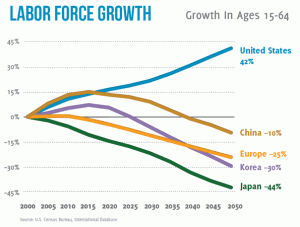A few hours ago, the New York Times authoritatively announced that the European Union has staved off financial disaster. German Prime Minister Angela Merkel is hailed as a hero by many in the European media! The long and the short of it is, they are giving Greece a break on some of its debt. Now, the EU can go back to growing their economy in peace …
Do not believe a single word of it.
The European Union is heading over an economic cliff. And no one wants to admit it.
They are going where only Japan has ever gone before: first into entrepreneurship decline (predominantly people aged 25 – 45), then into labor force decline (predominantly people 18 – 65), and ultimately into population decline (no explanation needed).
Japan was the first to go all the way through the process. Now, the declining population has resulted in declining real estate value. Every family with a house or business with property is finding that its most fundamental investment (real estate) is becoming more worthless every year. The aging population has caused Japan to have a debt to Gross Domestic Product ratio of 197.5%. They have almost twice as much debt as their entire economy produces in a year. And they are paying interest on all that debt.
Europe is walking down the same path.
What caused the decline in birth rates pushing the developed world towards population decline? Was it the invention of the Pill, a common belief?
No. John Mueller analyzed this claim in his excellent book Redeeming Economics.
Since the introduction of contraception, the pregnancy rates have remained steady.
Contraceptives have not decreased the number of unwanted pregnancies at all. This was actually predicted before-handed by both Planned Parenthood and the Catholic Church. However, since Roe v. Wade, roughly one in three pregnancies end in abortion. The entire decrease in babies and the resulting aging of the population is due exclusively to abortion.
But the entire developed world (except a few outliers like Poland and Ireland) has legal abortion. What makes the United States different? Why aren’t we going over the demographic cliff, too? Does something set us apart from Japan, China, and Europe?
Yes. Japan, China, and the nations of Europe were built on ethnic nationalism — the idea that because they share the same culture and heritage, they should act in collective self-interest. The United States was rather founded on the ideas found in the Declaration of Independence. Catholic British thinker G.K. Chesterton said: “America is the only nation in the world that is founded on a creed.” Because we were founded on a creed, immigration is a rich part of American heritage. Immigrants who believe the creed can truly become Americans. The same is not as true of an immigrant to an ethnic nation like France. But here waves of immigrants — the Germans, the Irish, the Italians, and the Latinos — have entered this country and now serve as a shield against the effects of abortion. Japan has no legal immigration while Europe’s immigrants are insufficient to stabilize the median age.
Does this mean that the United States was not hurt economically by abortion?
Absolutely not. When Roe v. Wade was legalized in 1973, the workforce did not immediately feel the adverse effects of abortion. The United States last reformed its immigration laws in 1986 (which included the Reagan amnesty for the 3 million illegal immigrants here at that time). However, in the early 1990s, the economy began to feel the pinch. A third of the workers that would have entered the marketplace at that time had been aborted. The dearth of young workers spawned the first waves of illegal immigrants.
Now, decades after Roe, the median age of whites in the U.S. has aged to 41. However, the median age for Latinos in the country is 27. The US business community has become fiercely pro-immigration — lobbying for non-enforcement of punitive immigration laws, increased guest worker passes, and increased levels of legal immigration. As the US ages (albeit more slowly than the rest of the developed world), the marketplace is increasingly ravenous for young workers and 20 million illegal immigrants currently live in the country, work, and pay taxes. Latinos also have significantly higher birth rates than whites.
Thus, when GOP Presidential candidates insist on “controlling the border first,” they are being naive or disingenuous. Controlling the border first would deny a ravenous market demand for young workers utterly unsatiated by current levels of legal immigration. They might as well say they are intent on “controlling the market first.” The only way that controlling the border would be affordable or even desirable would be to first adjust the levels of legal immigration to account for the demographic shift caused by abortion.
Then on to the big battle of overturning Roe v. Wade.



